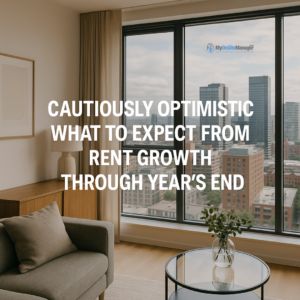As the year draws to a close, the U.S. rental housing market stands at an important crossroads. While demand remains strong and vacancy rates are still low in many markets, the explosive rent growth of recent years has cooled signaling a more balanced, but still cautious, outlook for the months ahead.
For landlords, property managers, investors, and renters alike, this period represents both opportunity and challenge. Understanding where the market is heading can make all the difference in shaping leasing strategies, pricing decisions, and operational priorities.
Steady Demand, Softer Rent Growth
Recent data reveals that rent growth across the nation is flattening out rather than falling off a cliff. According to Yardi Matrix, the national average rent increased by just 0.7% year-over-year in July, matching June’s performance. While this is a far cry from the double-digit spikes during the peak post-pandemic years, it still points to steady underlying demand.
This resilience is supported by strong absorption levels with over 300,000 new units absorbed through mid-year. If this momentum continues, 2025 could be one of the strongest years for leasing absorption since 2021.
What this means for property owners: The market isn’t overheated, but renters are still signing leases. That creates room for modest rent increases especially in desirable markets without pushing occupancy rates down.
New Supply Is Slowing Down (And That’s Good News for Stabilization)
One of the biggest factors shaping the rent outlook has been the flood of new construction over the past few years. More than one million units are currently under construction across the country, with many already entering the pre-leasing stage.
However, there are signs this construction boom is beginning to taper off. Rising financing costs and permitting slowdowns are causing some developers to pull back. As a result, the rate of new deliveries is expected to decelerate, easing the pressure on existing inventory.
For property managers, this means:
-
Less direct competition from brand-new buildings
-
More stable pricing power
-
A stronger position to retain tenants and protect margins
When new supply isn’t overwhelming the market, renewal strategies become more effective and pricing can be held steady or increased moderately without large concessions.
Market Performance Is Highly Localized
A key theme of this year’s rent growth story is regional divergence. The national average may look calm, but when broken down by metro area, the landscape tells a more complex story:
-
Chicago saw one of the highest annual rent increases at 4.1%, driven by limited new supply and strong urban demand.
-
Minneapolis–St. Paul and New Jersey posted more modest growth between 2.4% and 2.7%.
-
Meanwhile, markets like Austin are experiencing year-over-year declines of around –4.6%, though monthly figures show slight upward movement.
This uneven performance reflects local supply-and-demand balances, job growth trends, and even demographic shifts.
For leasing teams: A one-size-fits-all pricing strategy won’t work in this environment. Each metro (and often each submarket) requires a tailored approach:
-
In high-demand markets → moderate rent increases, shorter lease-up periods, and strong retention campaigns.
-
In softer markets → emphasize value, offer incentives, and focus on resident experience to maintain occupancy.
Economic Signals Are Mixed but Not Bleak
Macroeconomic conditions also shape rent growth expectations. Job growth ticked upward from June to July, indicating continued economic resilience. Inflation has cooled slightly, though interest rates remain elevated, and multifamily investment activity is subdued, with only a 1% year-over-year increase in transaction volumes in July.
These factors suggest a “cautiously optimistic” environment rather than a booming or collapsing one. Investors are taking their time, but renters are still out there and most are still paying.
For operators: This is a market that rewards operational discipline. Protecting NOI (Net Operating Income) means:
-
Controlling expenses (especially turnover costs)
-
Tightening leasing operations
-
Prioritizing renewals over high-cost turnovers
Strategies for Property Managers & Landlords
To navigate this transitional period effectively, property owners and operators can lean on smart strategies rather than aggressive pricing. Here are key recommendations:
1. Focus on Retention Over Turnover
Retaining existing tenants is cheaper than acquiring new ones. Even modest rent increases on renewals can boost long-term returns without eroding occupancy.
2. Get Granular with Market Data
National averages can be misleading. Track your specific market’s rent growth, absorption, and new deliveries closely to guide your pricing strategy.
3. Leverage Amenities & Service Experience
When aggressive rent hikes aren’t viable, enhancing the perceived value through amenities, maintenance responsiveness, and customer service can help keep your property competitive.
4. Prepare for Shifting Supply Conditions
With fewer new units on the horizon, markets may begin tightening again. Position your property early with renewal campaigns and targeted leasing efforts.
5. Protect NOI Through Operational Excellence
This is a good time to refine workflows, cut inefficiencies, and optimize vendor relationships. Efficient maintenance, fast unit turns, and tight leasing coordination can make or break margins.
Final Thoughts: A Market Built on Balance, Not Booms
The U.S. rental market isn’t heading toward a crash but it’s also not on a tear. Instead, it’s stabilizing. For many property managers and owners, this is actually a healthy shift. It encourages thoughtful pricing, better operations, and a focus on the long game rather than short-term spikes.
While caution is warranted, the fundamentals remain solid. Renters are still out there, absorption is strong, and new supply is easing. By staying nimble, data-driven, and service-focused, landlords can thrive in this more balanced environment.
Source: Yahoo Finance

